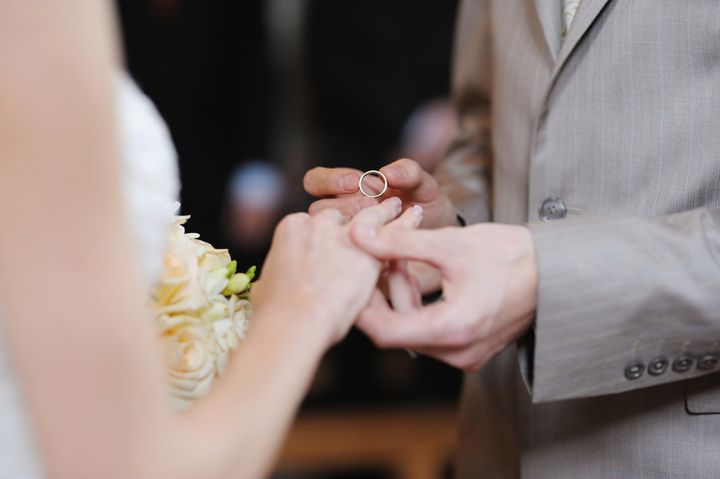
Spring is here, which means the start of the wedding season. So there's no better time to discuss literature that features... bad marriages!
But this will not be a totally negative post. Troubled fictional unions can serve as useful cautionary tales of mistakes real-life readers might avoid when looking to get hitched. And even if we don't view literary mismatches as educational tools, unhappy pairings can make for intense, dramatic, memorable reading.
Also, while bad marriages can make life miserable for literature's make-believe couples, the experience may help them make better choices the next time. So the cautionary-tale thing can help fictional as well as actual people!
One example of a troubled marriage is that of the sociable Kitty and dour Walter in W. Somerset Maugham's riveting The Painted Veil. The couple is so incompatible that Kitty has an affair that results in the angry and embarrassed Walter pushing her to accompany him to a cholera-ridden part of China for reasons that may involve revenge and/or a personal death wish. Lesson for real-life readers: Don't marry a weird guy because of pressure from your mother and a desire to wed before your sister does!
Another example of a bad marriage is that of Mr. and Mrs. Hines, two secondary characters in William Faulkner's gripping Light in August. In that novel's back story, the couple's daughter sleeps with a man who's partly black, and Mr. Hines reacts despicably -- with no regard for the feelings of Mrs. Hines or his pregnant daughter. Lesson: Don't marry an irresponsible, lawbreaking racist with no self-control.
Then there's the brutal Frank and gentle Ruth in Fannie Flagg's sublime Fried Green Tomatoes at the Whistle Stop Cafe. Ruth and Idgie love each other, but an open lesbian relationship in a pre-World War II small town is not easily in the cards. So Ruth reluctantly enters a disastrous marriage with the handsome Frank. Lesson: If you're not going to follow your heart, try to make sure the substitute has some humanity.
There's also a good-bad dichotomy in John Steinbeck's East of Eden, though the gender of the better person is different in this case. Adam is a decent guy and Cathy is, well, evil. Lesson: Don't marry a woman because of pity (Cathy is recuperating from bad injuries when Adam falls in love with her) and because you're more focused on good looks than a no-good personality.
Or how about Clara and Esteban in Isabel Allende's The House of the Spirits? The ethereal/clairvoyant/disorganized Clara has a kind and humanitarian nature, while Esteban is a methodical right-wing brute with some but not lots of decency. Lesson: Don't wed a man because you're supposedly not destined to marry for love.
In Edith Wharton's Ethan Frome, the title character is a taciturn but likable man while his wife Zenobia is a cold, bitter, hypochondriacal woman. Lesson: Don't marry a woman because she took care of your late mother and you feel lonely and in need of a replacement housemate.
Emile Zola's L'Assommoir (The Drinking Den) features the industrious Gervaise, a working-class woman who starts a successful laundry business; and her husband Coupeau, who eventually brings her down. Lesson: Don't marry a shiftless, alcoholic bum, even if he seems vaguely reliable at first.
Then there's the wonderful Jane Eyre novel I often mention. In the back story of Charlotte Bronte's book, a young Rochester is sort of tricked into marrying Bertha despite hardly knowing her and being unaware of her hereditary tendency to go mad. Lesson: Google the person you might wed, even if you live long before the Internet was invented.
In James Baldwin's Go Tell It on the Mountain, Elizabeth marries the minister Gabriel, who turns out to be a nasty guy with an unsavory past. One reason Elizabeth doesn't fully notice Gabriel's true nature at first is because she wants a stepfather for her son from a previous relationship that didn't end well. Lesson: Be aware that people are on their best behavior when courting.
What are you favorite fictional works featuring bad marriages? Optional bonus question: What lessons might readers glean from those works to help avoid real-life troubled unions?
(Note: I recently read The Painted Veil, Light in August and Fried Green Tomatoes because authors Maugham, Faulkner and Flagg were recommended by many commenters. They include "SeaSalty58," "jhNY," "ellarceehill," "skyecaitlin," "ae12wrangell," "Poor Ronald," "drb19810," "Pogopaws," "NiMRODPi," "MMII," "OurOrb," "fjg," Brian Bess, Jerry Zezima, Marilyn Wise, Jenny Rowland and Mary Harris, among others. Thank you!)
--
Dave Astor's memoir Comic (and Column) Confessional (Xenos Press, 2012) includes a preface by Heloise; back-cover endorsements by Arianna Huffington, "The Far Side" cartoonist Gary Larson and others; appearances by Hillary Clinton, Walter Cronkite, Coretta Scott King, Martha Stewart and others; and a mix of humor and heartache. If you'd like to buy a personally inscribed copy (for less than the Amazon price), contact Dave at dastor@earthlink.net.